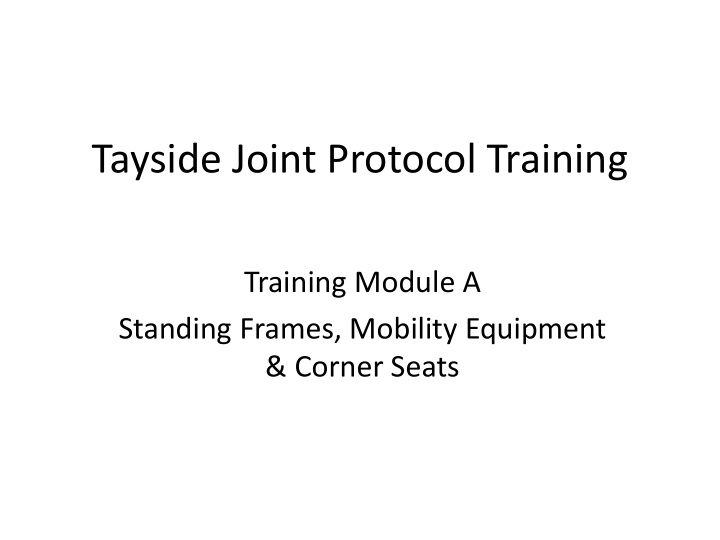



Tayside Joint Protocol Training Training Module A Standing Frames, Mobility Equipment & Corner Seats
Standing • During normal gross motor development, children being standing from as early as 9 months • This progresses to cruising at furniture, walking with hands held then independent walking • Postural control develops throughout this process
Why Standing is Important • Increased bone density & reduced risk of fractures • Facilitates formation of the hip joint in early development • Stretches muscles preventing the onset of contractures • Improved respiration & voice control • Enhances circulation & blood pressure • Aids digestion, bowel & bladder function • Enables eye-to-eye interaction with peers • Relieves pressure encountered during sitting • Improves wellbeing, alertness & sleep patterns
Assessment for using Standing Frames • Consider the following: – Complexity of disability – Muscle tone – high/low – Joint contractures & muscle length – Child’s abilities against gravity – head & trunk control – Deformity - including hip subluxation/ dislocation, scoliosis etc – Method of transfer into standing frame eg sit-stand with assistance, hoisted - type of sling – Height & weight of child, including length of body segments – Location of use
Lecky Prone Standing Frame • Aged 1 – 18 years • Available in sizes 1 -3 • Complexity: Complex • 5 incremental prone adjustments from 45 -85 degrees • Adjustable chest, pelvic & knee supports • Supportive sandals to optimise foot position • Can be used with head supports to reduce extensor posturing
JCM TIM Standing Frame • Available in 3 sizes for children 85 – 165 cm height • Complexity: Mild to complex • Angle of adjustment from -15 to 45 degrees • Allows for use as an upright or prone standing frame • Adjustable supports in depth, width & height
Patterson Medical Mini Standy • Available in 2 sizes • Complexity: Mild • Adjustable chest, pelvic, knee & foot supports • Removable table • Mobile base with castors • Max load = 55kg
Walking Aids • A variety of walking aids are available depending on the level of support required. • Many allow supportive attachments to be added or removed, depending on the child’s abilities. • Encourage independent mobility for those who require additional support. • Allows children to explore their environment independently and safely, at the same level as their peers • Encourages active use of muscles and joints, weight bearing and stimulates circulation. • Promotes physical fitness and exercise tolerance. • Improves child’s self esteem and inclusion.
Assessment for Walking Aids • Consider the following: • Child’s abilities – standing balance, weight bearing & walking/stepping • Postural control – trunk & head control • Use of upper limbs to maintain upright posture • Height & weight of child • Location of use – access and space for walking aid to be used
Nimbo Walking Frame • Available in 5 sizes – Junior to adult • Complexity: Mild to moderate • Various accessories, including: – Seat harness, pelvic stabiliser & forearm gutter supports • Lockable front castors • Anti-reverse rear wheels • Outdoor wheels, non- standard, must be requested when ordering
Rifton Pacer Gait Trainer • 5 sizes • Complexity: moderate to complex • Height adjustable • Variety of supports including: – Thoracic support, with tilt – Saddle seat – Thigh & ankle prompts – Upper limb supports – handles or gutter supports • Lockable castors with resistance adjustment
Corner Seats • Corner seats can provide an alternative means of supportive sitting, which can be functional and therapeutic. • Why Corner Seats are used: – To work on the development of sitting posture – Where sitting posture is absent, to allow inclusion to floor activities – To promote hamstring length with/without use of orthoses
Lecky Corner Seat • Age 1 – 14 years • Complexity: Mild to moderate • Enables long sitting on the floor for those requiring mild to moderate support • Accessories include: – Head pad – Tray • Portable with integral handle
Recommend
More recommend